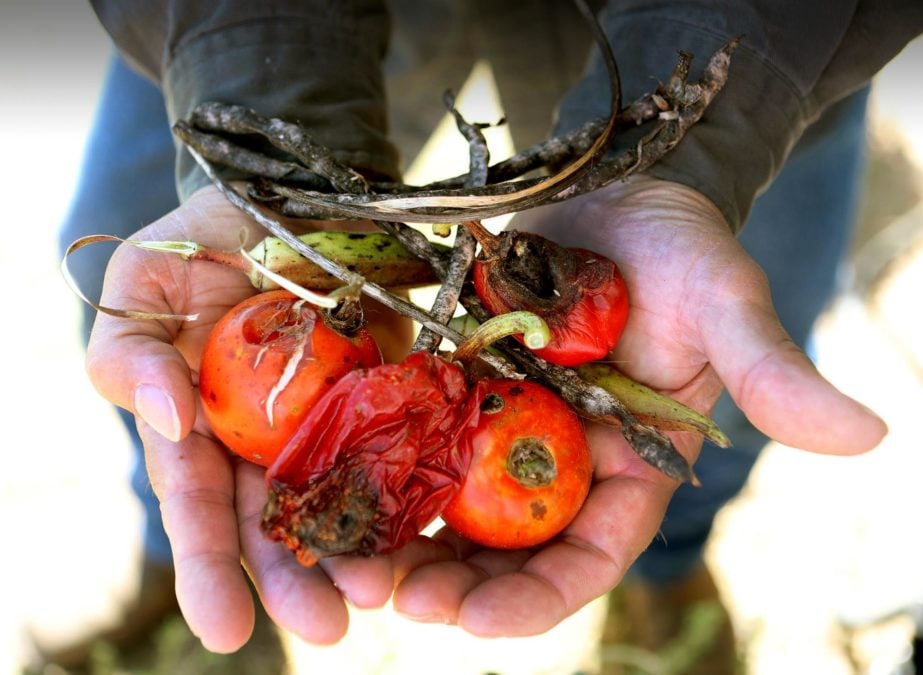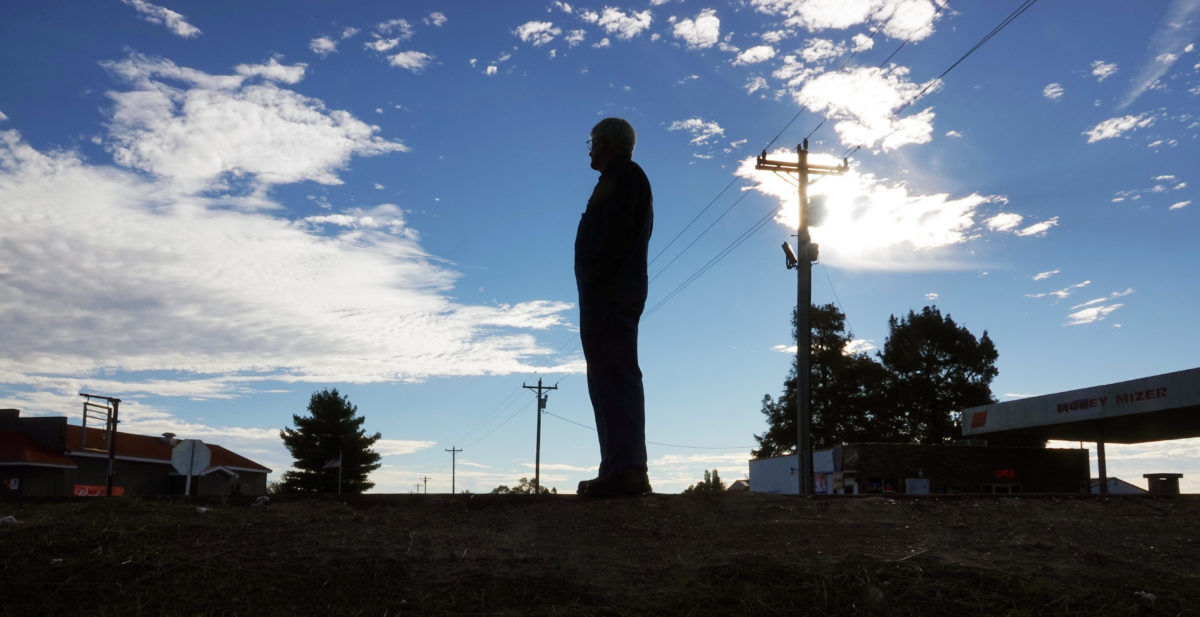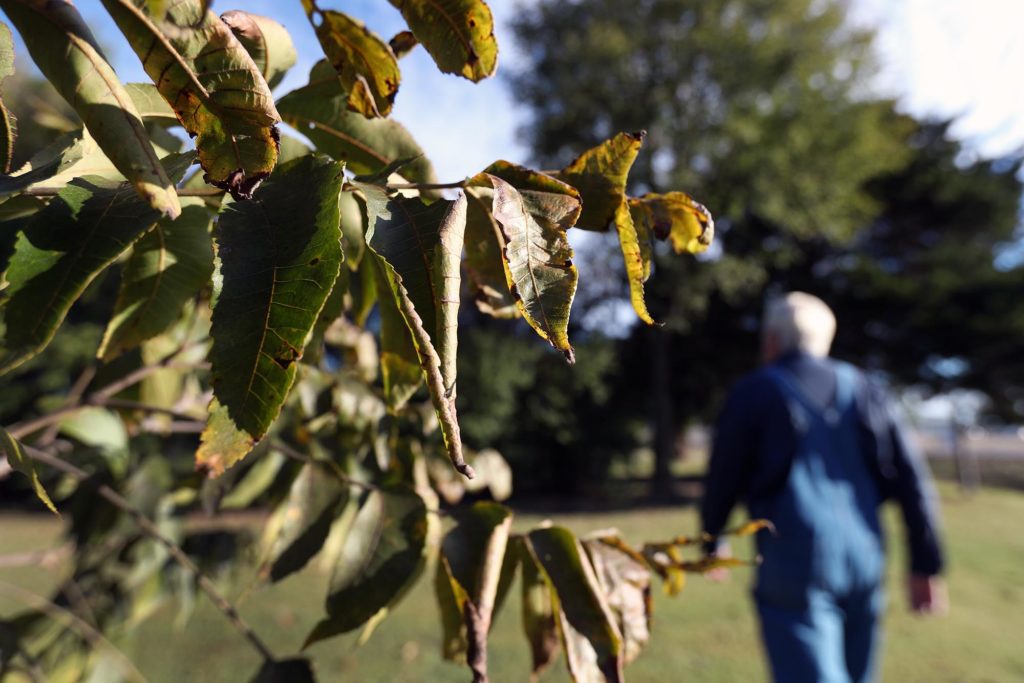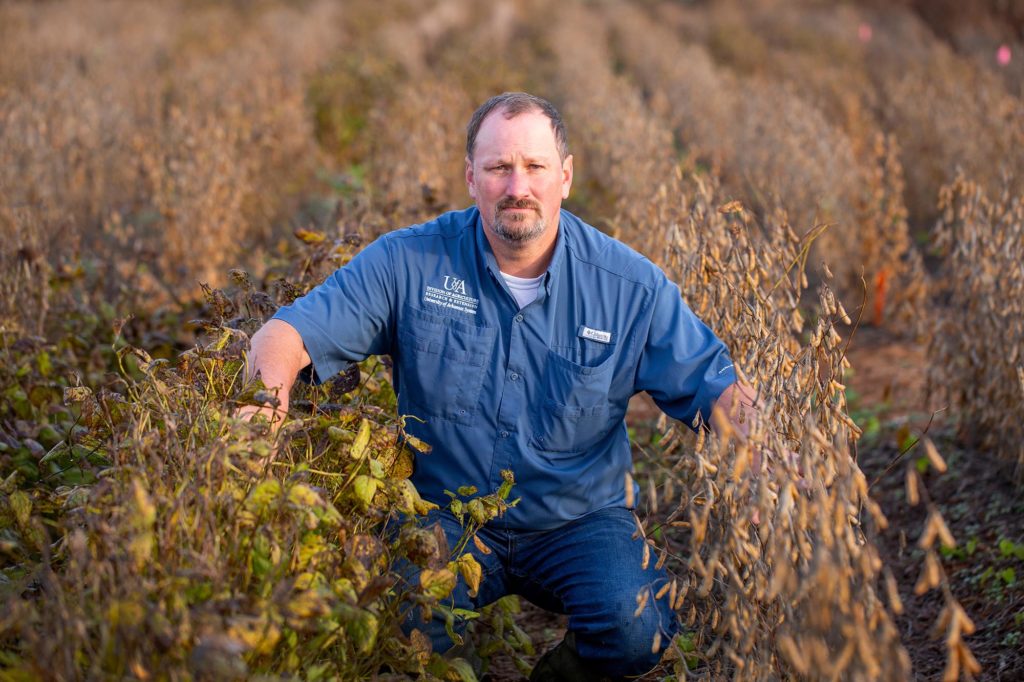
Every August, Andrew Joyce used to hunker down in the field beside his house, picking juicy, ripe tomatoes in the blazing sun. He’d load them onto his golf cart, along with buckets of okra, squash and other summer crops, and zip over to the farm stand he runs with his wife, Sara, off a two-lane highway near the Arkansas border. Sara’s Produce fans would drive hours to stock up on the artisanal fare, grown amid the fields of soybeans and cotton that reach toward the horizon of Missouri’s Bootheel.
“Everybody brags on my stuff,” said Joyce, 58, a wistful pride crossing his bronzed, weathered face.
But now, he has nothing to sell.
Joyce leans against the greenhouse he’s building, hands in the pockets of his overalls, peering at the field where he started nearly 800 tomato plants in the spring. It was early August when the telltale signs of trouble emerged. The plants’ broad, flat leaves shriveled and curled, their branches twisted and buckled. Then blossom rot set in. Joyce knew they couldn’t be saved. He climbed onto his tractor and mowed down his bestselling crop — for the third year in a row.
The plague that struck Joyce’s farm in Malden, Missouri, was not a natural disaster, but a man-made weed killer called dicamba. Farmers had applied the drift-prone chemical sparingly for decades. But in the past two years, its use has grown exponentially, and now dicamba is destroying millions of acres of crops worth millions of dollars, pitting farmer against farmer and scientists against manufacturers.
A joint investigation by Reveal from The Center for Investigative Reporting and the Food & Environment Reporting Network has found that the US Environmental Protection Agency — which is required by law to ensure pesticides don’t impose unreasonable environmental and economic costs — could have averted the destruction.
Two weeks ago, even though dicamba is causing widespread damage to crops and wild plants, the EPA approved the weed killer for another two years, stating that new label instructions will minimize the harm.
The EPA ignored scientists’ warnings and extensive research that showed dicamba would evaporate into the air and ruin crops miles away, according to documents obtained through public records requests and lawsuits. Instead, the EPA’s approval was based on studies by the companies that manufacture dicamba, which independent scientists say were seriously flawed. One scientist called the studies “shockingly insufficient.”
The agrochemical giant Monsanto Co. orchestrated the massive deployment of dicamba on tens of millions of acres of crops in the Midwest and mid-South when it lobbied the EPA to allow the chemical to be used on its genetically modified seeds for cotton and soybeans. The seeds — which the company engineered so that farmers could use dicamba to kill invasive weeds without hurting their crops — were worth $3 billion last year.
Issues with dicamba began to emerge under the Obama administration, which approved its expanded uses on a trial basis in late 2016. But even though the problems proved dire, President Donald Trump’s administration agreed twice to approve its use until at least the end of 2020.
For decades, US farmers applied this weed killer mostly on corn and other grass crops, which tolerate it. They took care not to spray it around soybeans, tomatoes and other broadleaf plants, which flinch at the slightest drop. Soybean and cotton growers never used dicamba during the growing season because it would have damaged their crops.
That changed when Monsanto launched an aggressive campaign in 2015 to sell soybean and cotton seeds genetically modified to resist dicamba. As a result, use of the weed killer has skyrocketed. In 2012, hardly any cotton or soybean farmers in Missouri and Arkansas used dicamba. But five years later, they sprayed more than 1 million pounds, according to the US Department of Agriculture. Over the past two years, under Trump’s watch, US farmers have planted more than 50 million acres of dicamba-resistant soybeans and cotton.
As farmers sprayed these crops in 2017 and 2018, scientists estimated that dicamba had damaged nearly 5 million acres of soybeans in 24 states, mostly Arkansas, Missouri, Tennessee and Illinois. (No one tracks damage to specialty crops such as tomatoes or home gardens, trees and wild plants.) Only two crops have been engineered to resist dicamba: soybeans and cotton. Every other broadleaf plant, including non-genetically modified soybeans and cotton, is at risk.
David Mortensen, an agricultural ecologist at the University of New Hampshire, is among the most passionate and vocal critics of allowing dicamba on genetically modified crops.
The EPA and Monsanto created a worst-case scenario, Mortensen said, by allowing and encouraging farmers to use an herbicide that kills a wide variety of plants at very low doses: “Dicamba-resistant crops should never have been released, period.”

Beginning in the 1960s, farmers had tended to spray dicamba only in late winter or early spring. In cooler weather, the chemical has less chance of evaporating, drifting through the air and harming other crops.
But a biochemist’s discovery 21 years ago ultimately would shatter those best practices.
Mortensen remembers listening, dumbstruck, as the biochemist described how he’d found a gene in soil bacteria that could make soybeans resistant to the weed killer. Mortensen knew that dicamba isn’t just prone to drifting to other fields. It’s also extremely hard to wash out of a spray tank. Farmers who rotated corn with soybeans or many other plants could kill their own crops inadvertently with the residue in their tanks. The idea of pursuing dicamba-resistant crops, Mortensen said, was “unfathomable.”
The biochemist, Donald Weeks, filed a patent on the gene in 1997. A worried Mortensen funneled his energy into research on dicamba while Monsanto developed Xtend seeds and a “low volatility” dicamba formula that wasn’t supposed to evaporate from fields and migrate through the air.
Then starting in 2015 — a year before the EPA approved the use of dicamba on genetically modified crops — Monsanto flooded magazines and social media with promises that its Xtend system would “extend your yield” and leave fields “spotless.” Monsanto’s marketers knew their audience: Growers in cotton and soybean country have few tools to control profit-stealing pigweed and other “superweeds.”
But the Reveal/FERN investigation shows that Mortensen amassed years of evidence on dicamba’s ability to drift into the air and destroy valuable plants, including the habitat of bees and other beneficial insects. He urged the EPA in 2016 not to register the weed killer for the new uses on genetically modified crops. Applying the product over large areas during the growing season in the heat of summer would cause widespread damage, he said. Plus, overreliance on a single toxic agent — whether herbicides or antibiotics — encourages the evolution of organisms that resist it. And with six weed species already showing resistance to dicamba, Mortensen warned the EPA, accelerating its use would speed weed resistance and at the same time pose “PROFOUND risks to broadleaf crop growers.”
Monsanto, however, told the EPA that weed resistance to dicamba was unlikely. It had made a similar argument in the early 1990s when it petitioned regulators to approve its new Roundup-resistant soybeans. Weeds wouldn’t evolve resistance, Monsanto claimed. But Monsanto was proven wrong when scientists documented resistance to Roundup two years after the genetically modified seeds hit the market. The company also assured the EPA that there was “no concern” about dicamba products drifting and harming other crops. That claim also was quickly proven wrong.
Yet the EPA repeatedly sided with Monsanto over the objections of Mortensen and other university scientists, first by registering dicamba in 2016 and then by keeping it on the market.
In addition, the EPA registered the weed killer with an inordinately complex instruction label that disregarded its tendency to evaporate and spread through the air — ultimately shifting the blame for drift problems to growers and applicators.
During the 2017 growing season, when several million acres of crops were damaged by dicamba, the nation’s top weed scientists formed a special committee to help the EPA avoid a similar disaster in 2018.
But the Trump administration instead focused on salvaging dicamba. The EPA announced new rules for spraying in October 2017 and again last month. In both cases, the agency said the changes would minimize drift. Yet the revised labels are even harder to follow — and do not ensure that dicamba won’t vaporize off fields.
Documents show that Trump’s EPA relied mostly on Monsanto’s advice last year when it decided to change the instructions on the label rather than restrict its use.
“Our expectation was for you all to send the EPA your proposed label changes,” Reuben Baris, acting chief of the herbicide branch of the EPA’s Office of Pesticide Programs, emailed top executives from Monsanto, along with dicamba manufacturers BASF and DuPont Co., last year.
“Our goal,” Baris wrote, “is to ensure these technologies are available to growers for the 2018 season.”
EPA officials declined to answer specific questions.
“The Agency looks at all of the evidence to inform our decision,” a spokesman wrote in an email. “EPA registered dicamba (with restrictions on its use) but placed time limits on the registration to allow the agency to either let it expire or to make the necessary changes in the registration if there are problems with resistant weeds or pesticide drift.”

Use of the herbicide is ratcheting up tensions in farm communities, even costing one man his life. A 55-year-old Arkansas soybean farmer died in October 2016 after a man he confronted over dicamba drift shot him. The man is now serving a 24-year sentence for second-degree murder.
“It’s just a very emotional thing because it can impact people’s livelihoods and, in some cases, their lives. That’s just tragic,” said Steve Eddington, a vice president for the Arkansas Farm Bureau.
Bees from Bobby Coy’s hives once pollinated neighbors’ farms. But now, Coy, who runs Coy’s Honey Farm with his wife and two sons, said they might leave Arkansas because those neighbors are spraying dicamba and bees don’t feed on dicamba-injured plants.
Coy will be 81 in a year and a half, when he’ll have paid off the $360,000 the family owes on the building where they extract honey.
“But if the dicamba don’t stop,” he said, “there’ll be no need for this building.”
The EPA denies that hives are at risk when dicamba is used according to the label instructions.
“We expect there will be no adverse impacts to bees or other pollinators,” the agency announced Oct. 31, when it approved dicamba for two more years.

But such assurances ignore evidence that dicamba harms bees by destroying the flowers they feed on. And they carry no weight with farmers such as Coy and Joyce, who’ve heard them from the EPA before. Joyce has been hit with losses three years in a row, costing him $30,000 — nearly as much as the typical household in this part of Missouri earns in a year. He complained to the state Department of Agriculture, as did several of his neighbors. An inspector confirmed dicamba was to blame, Joyce said, took pictures and left.
“I don’t have a bit of confidence in (Missouri officials) because they have failed to react,” he said. “And that goes for the EPA, too. They’re the ones that approved it.”
Joyce said he also worries about health effects from dicamba because he spends most of his days outside when his neighbors spray it. But there is no solid evidence that it poses human health risks.
Bill Bader, Missouri’s largest peach farmer, has lost tens of thousands of trees worth more than $1 million, according to a lawsuit he filed against Monsanto in 2016. Dozens of farmers seeking millions of dollars in compensation have joined Bader’s case.
Missouri and Arkansas issued emergency bans for the growing season in early July 2017, though it was too late for Joyce and Bader.
Just a few months into the 2017 growing season, the first time it was legal to spray dicamba on genetically modified crops, more than 1,400 complaints and more than 2.5 million acres of injured soybeans had been reported.
Those official complaints miss most of the damage. Many people don’t file complaints for fear of jeopardizing insurance claims, which typically address sprayer errors, not problems with the product itself.

Growers think they either can’t live with dicamba or can’t live without it, said University of Arkansas weed scientist Jason Norsworthy.
“I’ve been in this discipline for nearly 20 years and I’ve been in agriculture all my life, and I’ve never seen anything as divisive,” Norsworthy said.
For soybean farmer Perry Galloway, dicamba is the only thing that works against his nemesis, the pernicious pigweed.
“They’re so prolific and they’re resistant to all the herbicides,” said Galloway, a sixth-generation farmer in Augusta, Arkansas. A pigweed can produce a million seeds that can make a plant larger than a Christmas tree, he said, adding, “Dicamba was the only thing we had to fall back on.”
Galloway and five other farmers filed a lawsuit challenging the Arkansas ban last year. Galloway, who planted 4,500 acres of dicamba-resistant soybeans last year, said he hasn’t seen drift problems other farmers have complained about.
“I’m not saying that the widespread use of the newer formulations isn’t causing some of the problems,” he said. “But a lot of the complaints are not even related to herbicides, I don’t believe.”
Bayer Crop Science, which took over Monsanto in June, said dicamba complaints have dropped dramatically in the past year because applicators now are better trained. The company declined requests for interviews.
“Our customers tell us they’re seeing some of the cleanest fields in years and that they’ve had successful on-target applications of XtendiMax over broad acreage,” Bayer spokeswoman Charla Lord wrote in an emailed statement.
“The number of inquiries we receive each day is dropping, particularly compared to this same time last season,” she wrote. “Based on grower and applicator feedback and the decrease in off-target movement inquiries this season, especially among applicators, we continue to see that training and education are working.”
But Norsworthy said education and training will not fix a pesticide that doesn’t stay where it’s applied.
“Our commercial applicators did not wake up last year and forget how to spray,” he said.
Studies refute Monsanto’s claims
Monsanto was well aware that the chemical’s propensity to drift could imperil its chances of EPA approval. In a 2013 meeting with investors, Monsanto’s chief technology officer, Robert Fraley, said its new formula, XtendiMax with VaporGrip, “basically reduces the volatility to zero,” meaning that the product never would drift to unintended crops. Even so, Monsanto executives met with top EPA officials, notes from a February 2016 meeting show, to learn what would be needed “to create a defensible approach” to the concerns about drift.
That solution involved submitting studies that the company claimed proved XtendiMax was safe. Monsanto told the EPA that its research provides “multiple lines of evidence (to) demonstrate that there should be no concern of off-site movement due to volatility.” The company also reported that there was no need for a buffer zone to protect other plants as long as applicators used a specific spray nozzle.
But it turned out that these studies didn’t capture what happens in actual fields. In one type of study, called humidome experiments, soil is sprayed, then covered with plastic to measure how much turns to vapor.
“One thing we’ve learned this year, there is not a correlation between humidome data and what we see in the field,” Norsworthy told growers last year.
Monsanto also submitted field studies to support its claims. But the studies were not done in Arkansas, Missouri or other places where extreme summer heat favors vaporization. And they were too small to mimic the effects of applying the weed killer across vast acres, which loads the atmosphere with the chemical, making it more likely to drift, Mortensen said. He called the company’s studies “shockingly insufficient” in a statement supporting a lawsuit that rural farmers and environmental advocates filed against the EPA last year.
Monsanto refused to let independent university scientists test its product’s ability to drift before it hit the market in 2017. Then Norsworthy, University of Arkansas weed scientist Tom Barber and colleagues in other states quickly got to work. They mapped wind direction and damage to neighboring fields after spraying. They took greenhouse plants to fields a day after spraying and covered some with buckets during spraying. The results were consistent: Even when dicamba is sprayed exactly as directed, it evaporates over several days and damages plants.
For Barber, there’s a simple explanation for the gap between Monsanto’s findings and what he and his colleagues found: “I’m not trying to sell it.”
The scientists told EPA and Arkansas officials what they’d discovered in the summer of 2017.
“This is a product that is broken,” Norsworthy told state officials. “That’s what the data says, and … that’s a problem I can’t fix.”
But that same day, a top EPA official assured dicamba manufacturers that the agency is “working in partnership with our state regulatory colleagues to overcome any potential hurdles in the state registration process,” according to emails released through litigation.
State officials, however, urged the EPA to follow the science. If the product is “beyond salvaging — that call needs to be made,” an Alabama Department of Agriculture and Industries official said in an EPA conference call in August 2017. “Listen to research scientist(s).”
The EPA didn’t listen. But an Arkansas task force did. The panel recommended prohibiting dicamba applications on crops after April 15, when the risk of damage is greatest.
Monsanto fought Arkansas’ proposed ban, claiming it was based “on unsubstantiated product volatility theories.” Monsanto also attacked the scientists, accusing Norsworthy of endorsing a competing product. This, his university employer insisted, was not true. Many of Norsworthy’s colleagues expressed outrage at Monsanto’s attempt to discredit one of the nation’s most respected weed scientists, though they would not speak on the record about it.
“It’s difficult to make progress when there is denial, when individuals are unwilling to recognize the science,” Norsworthy said. “And there’s a wealth of science out there at this point.”
Now it appears that dicamba’s benefits to farmers trying to kill weeds could be short lived: Pigweed can evolve resistance to the chemical in just three growing seasons, Norsworthy’s research shows. It’s just a matter of time, he said, before weeds survive dicamba, rendering it useless, just as he and other scientists warned.

Meanwhile, more farmers are buying the genetically modified seeds in self-defense. In the 2018 growing season, acres planted with dicamba-resistant crops doubled, accounting for more than half of the 90 million acres of soybeans grown in the United States.
This time, most complaints about damage came from small farmers like Joyce, beekeepers with plummeting production and master gardeners with nothing to harvest.
Joyce isn’t sure whether he will grow tomatoes next year. He’s not sure he can continue farming at all. Looking around at his blighted vegetables, trees, rosebushes and flowers, it’s hard for him to grasp the scale of the destruction that dicamba has caused throughout soybean country.
“I don’t see how they can allow anything to go on damaging that much stuff,” he said.
![]()
Our most important fundraising appeal of the year
December is the most critical time of year for Truthout, because our nonprofit news is funded almost entirely by individual donations from readers like you. So before you navigate away, we ask that you take just a second to support Truthout with a tax-deductible donation.
This year is a little different. We are up against a far-reaching, wide-scale attack on press freedom coming from the Trump administration. 2025 was a year of frightening censorship, news industry corporate consolidation, and worsening financial conditions for progressive nonprofits across the board.
We can only resist Trump’s agenda by cultivating a strong base of support. The right-wing mediasphere is funded comfortably by billionaire owners and venture capitalist philanthropists. At Truthout, we have you.
We’ve set an ambitious target for our year-end campaign — a goal of $250,000 to keep up our fight against authoritarianism in 2026. Please take a meaningful action in this fight: make a one-time or monthly donation to Truthout before December 31. If you have the means, please dig deep.